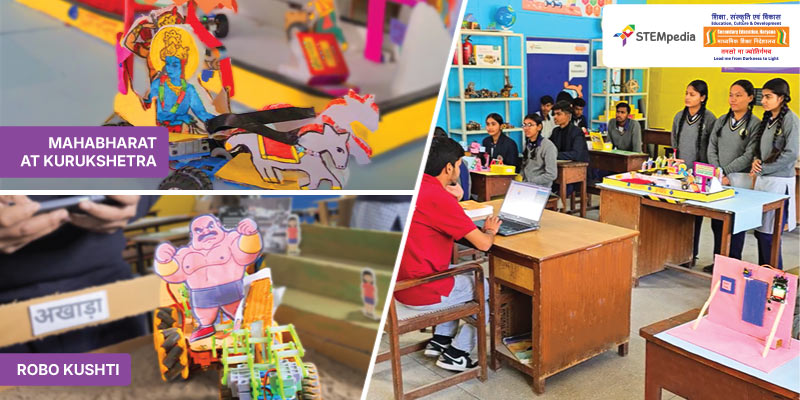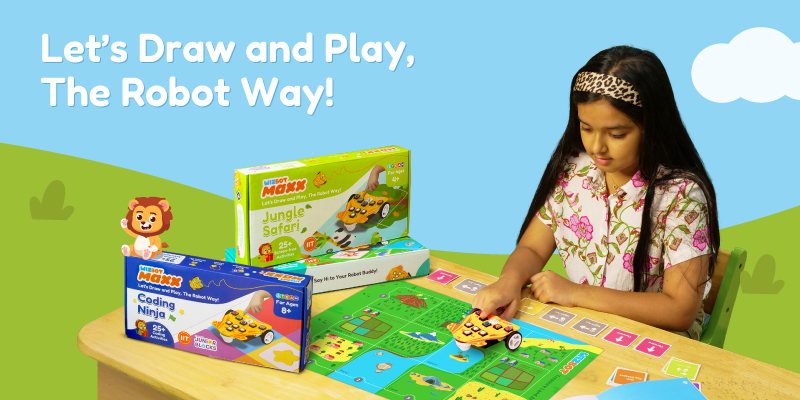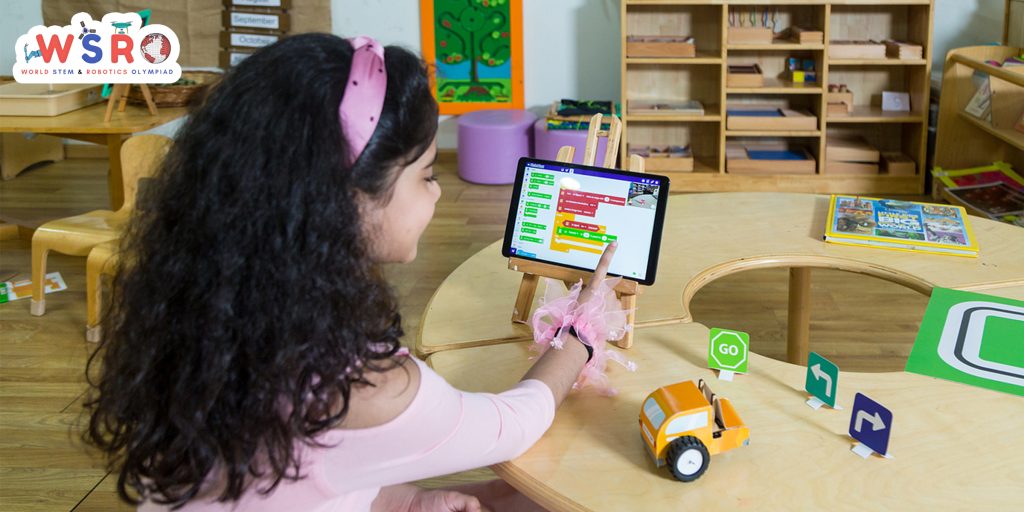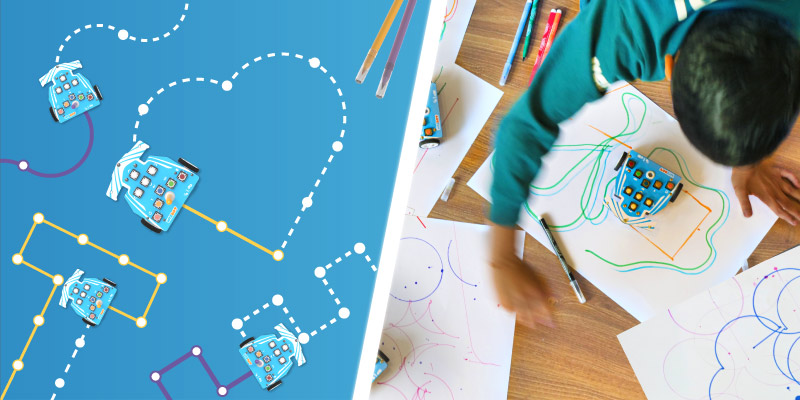The Department of School Education, Government of Haryana, in collaboration with STEMpedia, launched a transformative initiative to establish STEM Labs with AI, and robotics in 50 public schools across 13 districts. Officially initiated on April 1, 2024, this project goes beyond infrastructure; it introduces students to a future where technology meets tradition.
In these labs, students have brought ancient epics like the Mahabharata to life using robotics and built sensor-enabled tributes to local wrestling culture, proving that innovation comes to life when rooted in cultural identity.
The initiative is guided by the National Education Policy (NEP) 2020 and designed to foster 21st-century skills such as coding, tinkering, artificial intelligence, and robotics through inclusive, hands-on, and innovative pedagogy.
Building Future-Ready Classrooms for Students
The Haryana STEM lab project was designed to make schools future-ready by integrating 21st-century skills such as Artificial Intelligence, Robotics, and Coding into the school curriculum.
This initiative has reached more than 20,000 students from Classes 6 to 12, ensuring exposure to modern technology tools and hands-on learning. To support the implementation, over 150 teachers were trained to use the labs and deliver the curriculum effectively. This partnership sets a strong example of how government and private organisations can work together to improve the quality of education and bridge the digital divide.
| Metrics | Outcome |
|---|---|
| Number of Schools | 50 |
| Districts Covered | 13 Districts of Haryana |
| Target Grades | Classes 6 to 12 |
| Students Empowered | 20,000+ |
| Teachers Trained | 150+ School Teachers |
| Human Resource Deployed | Dedicated Expert Trainers from STEMpedia for Training, Mentorship, and Field Support |
| Project Launch Date | April 1, 2024 |
| Partners | Department of School Education, Government of Haryana, and STEMpedia |
Modern Lab Infrastructure for Hands-On STEM Learning
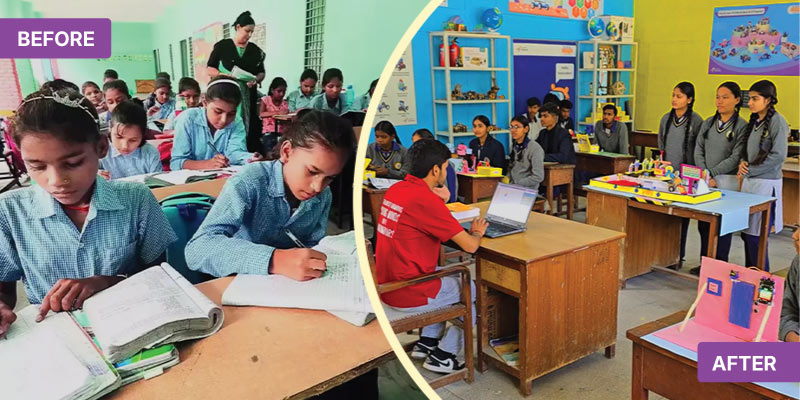
STEM Labs with AI and Robotics were established in all selected schools, with a clear focus on hands-on, experiential learning aligned with the goals of NEP 2020.
1. Tablets with Preloaded AI and Coding Software: Each lab was equipped with 16 tablets, pre-installed with PictoBlox, STEMpedia’s AI and coding platform. This allowed students to instantly begin working with beginner-friendly tools for AI, machine learning, and robotics.
2. High-Speed Wi-Fi Access: All labs were connected to high-speed internet made possible by the Department of School Education, Government of Haryana. This enabled uninterrupted access to learning modules, coding uploads, and online collaboration.
3. Educational Quarky Robotics Kits: Every lab received Quarky kits for building and programming intelligent robots, enabling students to apply their learning in real-world problem-solving contexts. To enhance student exposure and learning outcomes, the kits were supported with:
-
- Sensor modules, motors, and actuators for hands-on electronics integration
- Themed activity booklets and project guides mapped to grade-wise learning objectives
- Interactive content on PictoBlox facilitates AI, ML, and coding education
- DIY project kits to promote creativity, critical thinking, and experimentation
This comprehensive set of tools ensured that students engaged in complete STEM cycles: from ideation and prototyping to testing and showcasing.
4. Integrated Learning Management System (LMS): A structured LMS platform was deployed across all labs to help teachers deliver content, track student progress, and access digital resources efficiently.
5. Optimal Lab Capacity: Labs were designed to support 30-40 students per session, utilising rotational timetables to ensure smooth operations without overcrowding.
The shift from traditional classrooms to innovative, technology-enabled labs was visible through before-and-after photographs, demonstrating a measurable upgrade in the learning environment and infrastructure.
STEM Curriculum Implementation in Regional Language
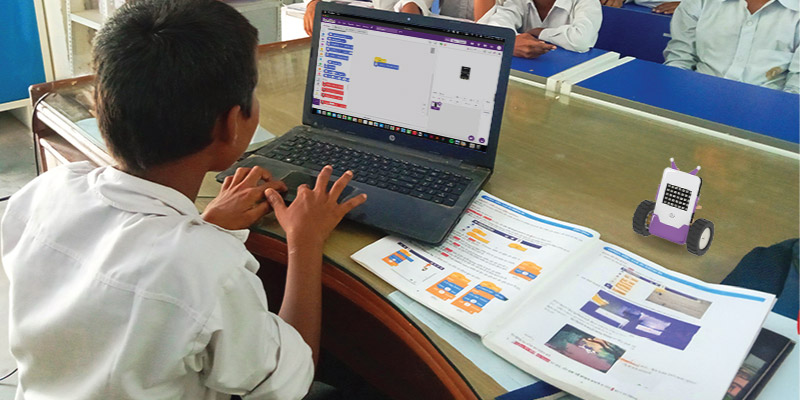
One of the most impactful components of the Haryana AI and Robotics Lab initiative is its structured integration of STEM into the regular school timetable, paired with a regional language-first approach. Together, they established a model of innovative pedagogy that is both inclusive and equitable, aligned with the vision of NEP 2020 and NIPUN Bharat.
-
Curriculum Timetable Across Grades 6-12
A carefully planned timetable assigned lab periods for every grade, from Classes 6 to 12, ensuring that all students had regular access without classroom overlaps or overcrowding.
Example: GSSS Sector 19, Panchkula’s timetable demonstrates how STEM periods are distributed throughout the week, maximizing lab usage and minimizing scheduling problems.
Days Periods Days 1 2 3 4 5 6 7 8 Monday - 12th C Deepa - 7th B Monica (Che) 9th B
Jyoti10th A Mamta Rani 9th C Hitesh Tuesday - 11th D Anita - 8th B Sarbjeet 7th D Monica (M) 9th A Sarbjeet Wednesday - 7th A Yashwant - 7th C Gayatri Lunch Break 8th A Mamta Thursday - 12th D Anita - 12th B Rajvinder 11th B Ravinder 12th C Asha Friday - - 9th D Hitesh 10th D Sarbjeet 10th B Jyoti Saturday - 12th A Harneet - 8th C Jyoti 9th E Monica (Che) 10th C Monica (Che) 11th A Mamta -
Subject-Specific Teacher Allocation
Teachers were assigned based on subject expertise to ensure focused guidance in AI, Robotics, and Coding. This subject-specialist model empowered students with deeper, domain-specific learning support.
(e.g., Monica – Chemistry, Sarbjeet – Robotics) -
Regional Language Implementation at All Levels
All curriculum-aligned materials, including printed textbooks for students and instructional guides for teachers, were provided in Hindi, the regional language of Haryana. The material also includes digital content on PictoBlox to learn coding, AI, and robotics in a fun and interactive way. This removed barriers to understanding and empowered students to learn complex AI and coding concepts in a language they understood deeply.
-
Multilingual Readiness for Replication
The program model has been designed for easy adaptation across different states, allowing future implementations in regional languages such as Telugu, Marathi, or Gujarati. This makes it scalable, inclusive, and highly relevant for non-English-medium public schools.
-
Inclusive, Culturally Rooted Learning Materials
Students are solving problems and expressing creativity in ways that reflect their communities and environment. This project is a seamless blend of tech, accessibility, and contextual relevance that transforms how students in public schools experience STEM learning, owing to the essence of innovative pedagogy.
Teacher Training and Capacity Building in STEM
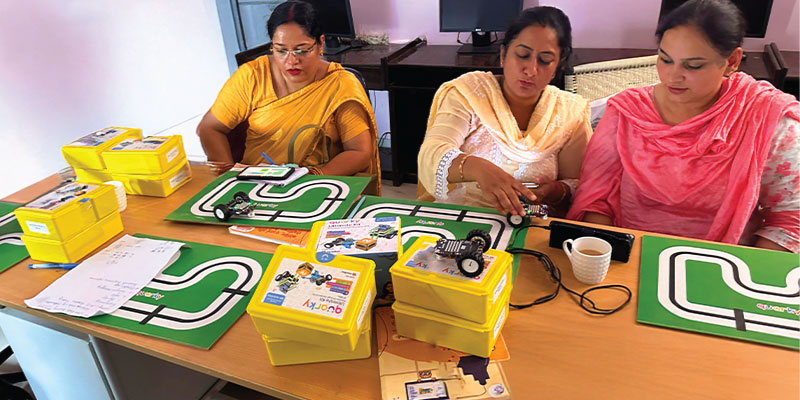
The Haryana AI and Robotics Lab initiative invested heavily in teacher training and institutional capacity building. This ensured that government school educators were not just users of technology, but confident facilitators of hands-on, future-ready learning.
- 150+ Government School Teachers Trained Across 50 Schools
An average of 3 teachers per school were trained, creating a sustainable human resource model to support rotational lab sessions across grades and subjects. - STEMpedia deployed dedicated technical trainers across the 50 government schools. These on-ground experts played a pivotal role in the day-to-day implementation by:
- Guiding students through hands-on robotics activities using Quarky robotics kits
- Supporting teachers in integrating AI and coding lessons using PictoBlox
- Facilitating activity-based pedagogy as promoted by NEP 2020
- Providing continuous project mentorship, troubleshooting, and reporting
- Continuous On-Ground Mentorship and Support
After the core training, teachers received weekly in-school mentoring visits and field-level technical support from STEMpedia’s implementation team, ensuring real-time assistance and building their confidence. - Access to Personalized Learning Management System (LMS)
Every trained teacher was onboarded to the LMS platform, providing:- Self-paced digital upskilling
- Ready-to-use lesson plans and tutorials
- Step-by-step teaching guides
- Student progress tracking and classroom analytics tools
This capacity-building model enabled schools to run lab activities independently, support interdisciplinary projects, and scale student engagement.
Student Innovation and AI Projects in Schools

The Haryana STEM Lab initiative put experiential, hands-on learning at the center, allowing students to move beyond theory and actively build solutions grounded in their environment and culture. Students from Grades 6 to 12 were engaged in structured activities, culminating in original projects that combined technical skills with local relevance and social meaning.
Each student project was designed to reflect real-world application, empathy, and creative expression through AI and Robotics.
Top Projects Created by Students:
 Robo Kushti – Paying homage to Haryana’s traditional wrestling culture, this project used sensors, RGB lighting, and thematic visuals to create a modernized, interactive version of a kushti match, merging heritage with technology.
Robo Kushti – Paying homage to Haryana’s traditional wrestling culture, this project used sensors, RGB lighting, and thematic visuals to create a modernized, interactive version of a kushti match, merging heritage with technology.
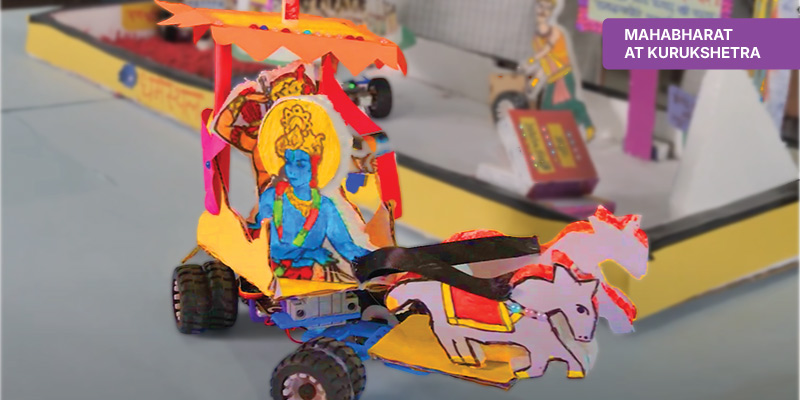 Mahabharat at Kurukshetra – A storytelling innovation that dramatised episodes from Indian mythology using Quarky robots and PictoBlox animations, combining literature, history, and robotics for a compelling cultural presentation.
Mahabharat at Kurukshetra – A storytelling innovation that dramatised episodes from Indian mythology using Quarky robots and PictoBlox animations, combining literature, history, and robotics for a compelling cultural presentation.
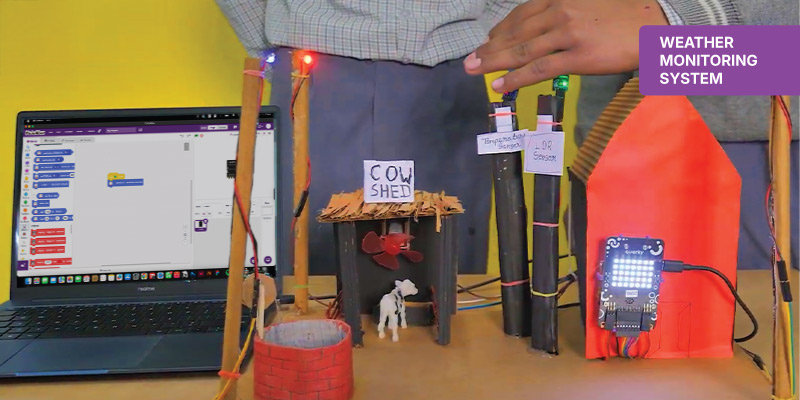 Weather Monitoring System – A student-built IoT project that used sensors to capture real-time weather data, teaching students how to integrate hardware and data-driven decision-making for community benefit.
Weather Monitoring System – A student-built IoT project that used sensors to capture real-time weather data, teaching students how to integrate hardware and data-driven decision-making for community benefit.
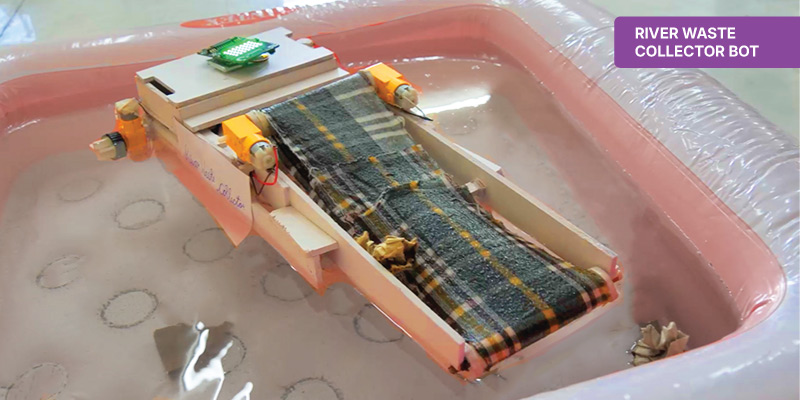 River Waste Collector Bots – Inspired by local concerns of river pollution, students designed mobile bots capable of simulating waste collection, reflecting eco-consciousness and problem-solving.
River Waste Collector Bots – Inspired by local concerns of river pollution, students designed mobile bots capable of simulating waste collection, reflecting eco-consciousness and problem-solving.
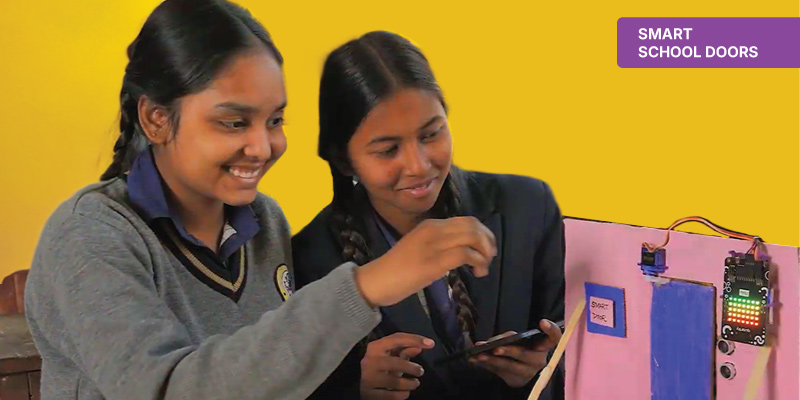 Smart School Doors – An automation-focused project where students created doors with security sensors and voice alerts, addressing school safety while learning about sensors and real-time processing.
Smart School Doors – An automation-focused project where students created doors with security sensors and voice alerts, addressing school safety while learning about sensors and real-time processing.
Gender Inclusion and Social Impact through STEM Education in Haryana Government Schools
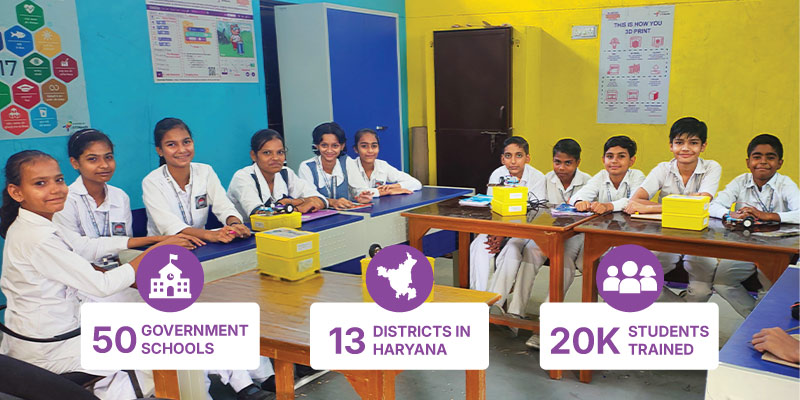
The Haryana AI and Robotics Lab initiative placed a strong focus on equitable STEM access, aligning with the visions of Beti Bachao Beti Padhao, Digital India, and NEP 2020. The goal was not just to introduce technology but to break social and gender barriers in education.
Across 50 government schools in 13 districts, more than 20,000 students experienced hands-on AI and robotics education for the first time, many of them from rural and semi-urban communities.
- Of these, over 10,000 were girls, marking a significant breakthrough in STEM engagement among female students.
- Before the installation of STEM labs, schools typically saw only 7 to 10 girls participating in technology-related activities. Post-implementation, this number grew to 25- 30 girls regularly attending and engaging in AI and robotics sessions. This marked a threefold increase in girl student participation, underscoring the role of access, hands-on learning, and regional-language content in fostering inclusion.
- Overall, classroom engagement also rose significantly. Average participation per session across grades grew from around 15-20 students to over 35-40 students, with both boys and girls showing renewed interest in school attendance, particularly on lab days, and a noticeable increase in active involvement during hands-on activities.
Through inclusive design and localised implementation, the initiative has not only closed gender gaps in access to technology but also created a model of social impact that is scalable and replicable for other regions.
| Sr. No. | District | School | Number of Projects | Number of students |
|---|---|---|---|---|
| 1 | Ambala | GMSSSS Barara | 3 | 5 |
| 2 | Ambala | GMSSSS Police Line | 9 | 17 |
| 3 | Ambala | GMSSSS Samlehri | 4 | 7 |
| 4 | Ambala | GMSSSS Shehzadpur | 4 | 7 |
| 5 | Ambala | GSSS Baldev Nagar (Ambala City) | 3 | 8 |
| 6 | Faridabad | GGSSS Faridabad Old | 3 | 5 |
| 7 | Faridabad | GMSSS Sector-28 | 4 | 8 |
| 8 | Faridabad | GSSS Faridpur | 4 | 8 |
| 9 | Faridabad | GSSS Jasana | 5 | 10 |
| 10 | Faridabad | GSSS Sector-3 | 4 | 7 |
| 11 | Fatehabad | GMSSSS, Bhuna (3267) | 15 | 29 |
| 12 | Fatehabad | GSSS, Amani, Tohana (3290) | 5 | 9 |
| 13 | Gurugram | GMSSS Farrukh Nagar | 5 | 9 |
| 14 | Gurugram | GSSS Bhora Kalan | 10 | 19 |
| 15 | Gurugram | GSSS Nathupur | 8 | 18 |
| 16 | Gurugram | GSSS Sec. 4/7 Urban Estate | 13 | 31 |
| 17 | Gurugram | GSSS Sherpur (Pataudi) | 5 | 9 |
| 18 | Hisar | GMSSSS Adampur | 7 | 14 |
| 19 | Hisar | GMSSSS Uklana | 6 | 9 |
| 20 | Hisar | GSSS Bhatol Kharkara | 3 | 6 |
| 21 | Hisar | GSSS Satrod Khurd | 5 | 8 |
| 22 | Hisar | GSSS Siwani Bolan | 5 | 15 |
| 23 | Karnal | GGMSSSS Railway Road | 11 | 17 |
| 24 | Karnal | GMSSSS Gharaunda | 12 | 22 |
| 25 | Karnal | GMSSSS Taraori | 13 | 22 |
| 26 | Nuh | GMSSSS Ferozpur Jhirka | 2 | 3 |
| 27 | Nuh | GMSSSS Nuh-1 | 1 | 2 |
| 28 | Palwal | GGSSS Palwal Camp | 1 | 2 |
| 29 | Palwal | GMSSSS Dhatir | 1 | 2 |
| 30 | Palwal | GSSS Aurangabad | 1 | 2 |
| 31 | Rohtak | GMSSSS Bhiwani Road Rohtak | 11 | 31 |
| 32 | Rohtak | GMSSSS Lakhan Majra | 8 | 8 |
| 33 | Rohtak | GMSSSS Sampla | 7 | 17 |
| 34 | Rohtak | GMSSSS Sanghi | 10 | 10 |
| 35 | Sirsa | GGSSS Sirsa, Mela Ground (2845) | 10 | 17 |
| 36 | Sirsa | GSSS Mithri (2873) | 10 | 22 |
| 37 | Sonipat | GGSSS Bidhal | 8 | 21 |
| 38 | Sonipat | GMSSSS Beeswamile | 4 | 10 |
| 39 | Sonipat | GMSSSS Nahri | 7 | 8 |
| 40 | Sonipat | GSSS Baroli | 5 | 11 |
| 41 | Sonipat | GSSSS Barotha | 8 | 19 |
| 42 | Yamuna Nagar | GMSSSS Bilaspur | 5 | 15 |
| 43 | Yamuna Nagar | GMSSSS Radaur | 11 | 29 |
| 44 | Yamuna Nagar | GSSS Alahar | 6 | 25 |
| 45 | Yamuna Nagar | GSSS Kalawar | 4 | 14 |
| 46 | Panchkula | GSSS Sec-19, Pkl | 6 | 16 |
| 47 | Panchkula | GSSS Pinjore | 4 | 11 |
| 48 | Panchkula | GMSSS Bataur | 1 | 2 |
| 49 | Panchkula | GSSS, Sector-6 | 2 | 6 |
| 50 | Panchkula | GMSSS Raipur Rani | 2 | 6 |
| Grand Total | 50 | 301 | 628 |
Student Exposure Through District to National Level STEM Competitions
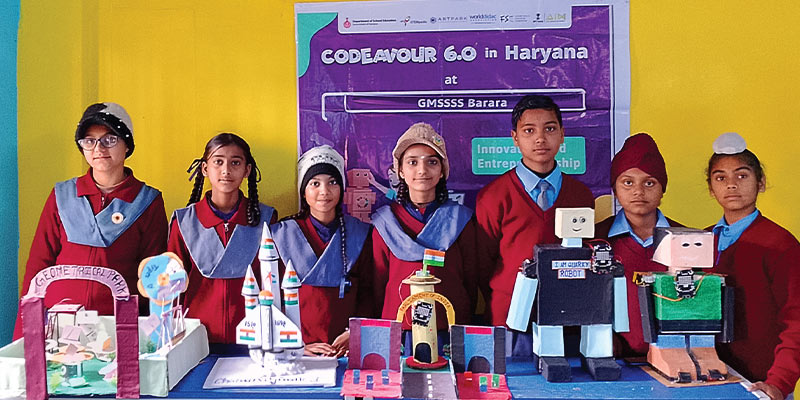
A structured competition framework was developed as part of the Haryana AI and Robotics Lab initiative to sustain student engagement, amplify innovation, and provide recognition at multiple levels. This ecosystem allowed students to grow from local problem-solvers to confident national-level participants.
Intra-School and District-Level Competitions
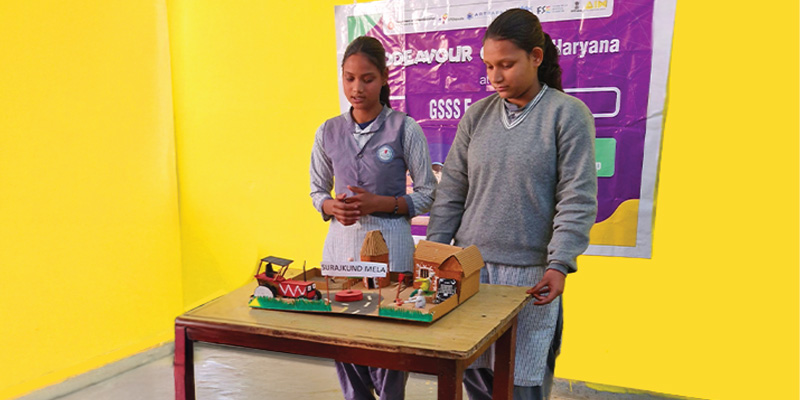
The journey began with intra-school and regional competitions, where students presented their AI and robotics projects within their schools. These internal showcases created a safe, supportive space for students to build confidence, receive feedback, and gain peer motivation.
From there, standout teams were invited to participate in district-level showcases held across the 13 participating districts. These state-level events were pivotal, as they:
- Brought together students from all 50 government schools, enabling cross-district collaboration and healthy competition.
- Featured real-world projects rooted in students’ local contexts—from sensor-enabled cultural storytelling to eco-robots for river waste collection and AI-based safety automation.
They were attended by education ministry delegates, government officials, parents, and school heads, creating a strong platform for public visibility and community pride.
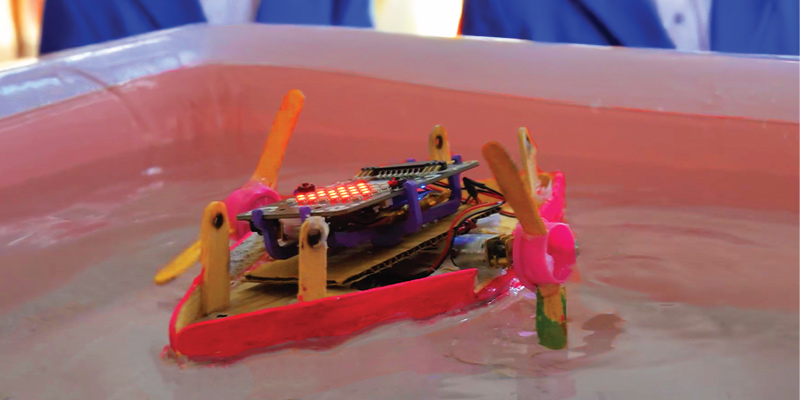
Beyond competition, these events helped foster:
- A spirit of innovation and teamwork,
- Stronger presentation and communication skills, and
- A deeper sense of ownership in learning outcomes.
Codeavour 6.0 India Nationals: Bridging State Efforts with National Exposure
The most significant milestone came when students from these government schools advanced to Codeavour 6.0 India Nationals, India’s largest AI and Robotics championship for school students. Their participation represented not just talent, but the success of a public education transformation.
At Codeavour Nationals, Haryana’s students:
- Competed alongside peers from private institutions and schools across India,
- Presented solutions built using Quarky kits and PictoBlox, and
- Showcased their technical competency, creative problem-solving, and growth through structured exposure to AI and robotics.
For many students, particularly from rural and semi-urban regions, this was their first time on a national stage, gaining experience, confidence, and recognition that extended beyond their classrooms.
Community and Institutional Impact
This competition framework evolved into a sustained culture of innovation, reinforced by:
- Community participation and leadership endorsement at events,
- Renewed interest in STEM subjects among younger students, and
- Regular integration of project-making and exhibitions into school life.
The Haryana STEM Lab initiative with AI and Robotics has empowered students through bridging grassroots participation with national recognition,
Monitoring, Evaluation, and Long-Term Sustainability
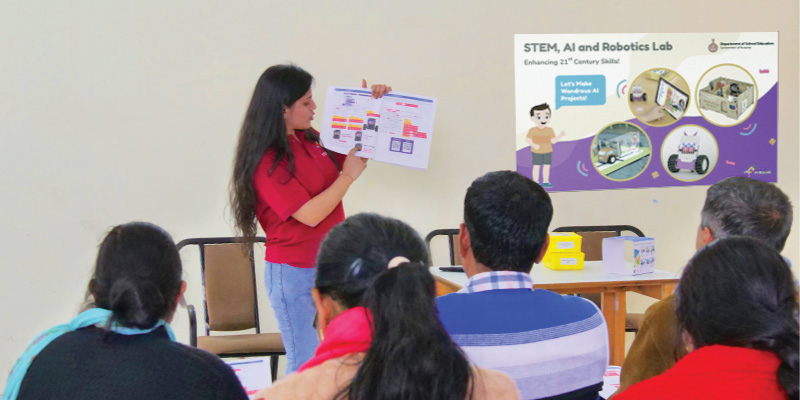
A comprehensive two-year monitoring and evaluation plan was established to ensure sustained impact and measurable outcomes across all 50 government schools.
- These integrated Structured data collection mechanisms from the start:
- Regular inputs were captured through the Learning Management System (LMS),
- Supplemented with field visits by the STEMpedia team, conducted at both school and district levels.
- Over 75+ periodic school visits were made during the first year alone, offering continuous academic and technical support to educators and students. These visits enabled:
- Troubleshooting lab operations,
- Gathering feedback from teachers and students,
- Tracking the integration of curriculum, usage of hardware/software, and student participation.
- A centralized reporting framework helped monitor milestones across labs, including equipment usage, the number of sessions held, attendance rates, and project submissions.
- Dashboards and visual tools were utilized to provide real-time performance analytics, making them accessible to government stakeholders for transparent tracking.
- Photographic documentation, student project videos, and teacher observations offer qualitative evidence of impact.
These continuous feedback loops ensured the program could adapt and evolve dynamically, keeping the model relevant, efficient, and scalable for replication in other states.
Key Impact Highlights from the Haryana STEM, AI, and Robotics Initiative
Beyond numbers and milestones, the Haryana AI & Robotics Lab project revealed clear patterns of excellence that set it apart. These recurring strengths underscore the thoughtful design and impactful execution behind the initiative
| Description | |
|---|---|
| Targeted Scheduling | Lab periods were intelligently slotted to ensure smooth, multi-grade participation without overlap. |
| Teacher Empowerment | Deep engagement through structured training and weekly mentoring visits for educators builds institutional capability. |
| Cultural-Technology Blend | Projects rooted in Haryana’s traditions and problems demonstrate powerful contextual learning. |
| Gender Empowerment in Tech | 10,000+ girls accessed AI, Robotics, and Coding, a transformative step for gender equity. |
| Transparent Deployment | From device allocation to infrastructure transformation, the project maintained transparency and accountability through meticulous documentation and visual records |
In a Nutshell: A Scalable Model for Educational Innovation
The Haryana STEM Lab project with AI and Robotics stands as a powerful example of how visionary policy, thoughtful technology integration, and local implementation can converge to redefine education. It translates the aspirations of NEP 2020 into practical, daily classroom experiences. It transforms students from passive consumers into active creators. And it uses technology not as a gimmick, but as a meaningful tool for critical thinking, collaboration, and creativity.
Thousands of students across 50 government schools are now building robots, designing solutions, and reimaging their surroundings. This initiative between the Department of School Education, Government of Haryana, and STEMpedia offers a replicable model for future-ready education, grounded in equity, empowerment, and innovation.

